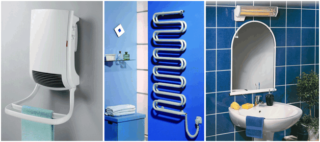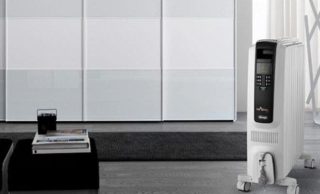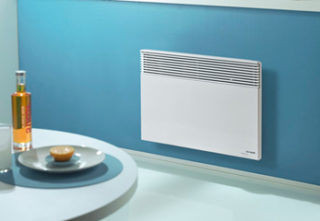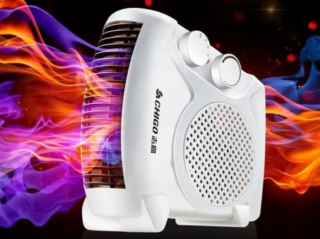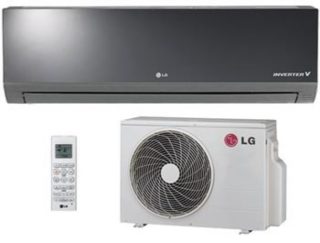The room where they take bath procedures should be warm, comfortable and safe. A distinctive feature of this place is high humidity. Therefore, it is important to choose the right heater for the bathroom. The heater must withstand the loads of the environment and effectively perform its tasks. All devices with an IP24 code of protection class respond to this.
What to consider when choosing a heating option
There is a certain list of requirements that must be met by electrical or other devices designed to maintain a comfortable atmosphere in the bathroom:
- Immunity of the heater to sudden changes in temperature.
- Safe operation of the device, regardless of its direct contact with water or the effect of high humidity on the case.
- Resistance of the external coating of the product to corrosion, and electrical contacts to oxidation.
- Compact overall dimensions with limited space.
- Sufficient heat capacity that can block the heat loss of the room in the cold season;
- Aesthetically attractive appearance of the device, harmoniously blending into the interior.
Modern bathroom heaters should be economical and maintenance costs minimal.
Types of heaters and their features
There are several signs by which it is possible to classify heating devices designed for heating, including the bathroom:
- according to the principle of operation - electrical devices, steam heating radiators, stoves;
- according to the installation method - floor, wall or ceiling execution;
- by appointment - household and industrial.
Most often at home they use electric appliances for heating. This is due to their simplicity, reliability, durability and relatively simple installation.
Oil cooler
Most often, this type of heater has a floor design and it has wheels for mobile movement. A feature of the radiator is that it is very inert - it heats up for a long time and does not cool down quickly, due to which it gives off heat even when it is turned off. The heater is safe, because its spiral does not contact directly with the environment, but is hidden in a sealed enclosure filled with mineral oil. The radiator does not burn oxygen, but it can not be called economical, which is partially offset by the built-in thermostat. The unit weighs decently.
For a small bathroom, which minimally contacts the external walls and requires heating if necessary, it makes sense to put an oil cooler.
Convector heating
The design of electric convectors involves the presence of a heating coil, which directly affects the air. Thanks to convection, already warmed air mixes with cold air, and so on, until the whole space is warmed up. With a high power of 2 kW and above, the devices are able to warm up the room in a minimum time, but they quickly cool down when turned off. Electroconvectors are silent, efficient, but burn oxygen and dry the air.
When installing this type of device, it is important to think about protecting it from direct spray. Excessive moisture can damage the decorative surface and cause a short circuit.
Electric heater with fan
In fact, this is the same convector, only equipped with a mechanism for forced injection of hot air in the form of a fan. Usually these are powerful quick-action devices in terms of heating the room.
Their most significant drawback is increased noise and colossal electricity consumption. To consider this option as the main one for heating even a small room is not entirely practical. More fan heater is suitable as a backup heater in case of breakdowns of the main system.
Infrared heater
Unlike devices that heat the air, infrared radiation directly affects all surrounding objects that are in the field of action, making them warm. An infrared heater is easy to distinguish from others - when turned on, its spiral acquires a bright orange color and, as a rule, there is a reflector. Due to the built-in temperature controller, this type of devices can be considered energy efficient. It feels like these emitters give an instant comfortable thermal effect. On sale you can find wall, ceiling heaters and raised on a support.
Modern ceramic heaters, which are also referred to as infrared, have a record low energy consumption, starting from 270 watts, and a high degree of heating of the working surface.
Inverter type air conditioner
This type of electric heater is an air-to-air heat pump. In it, the refrigerant with a low boiling point is heated by street air and brought to a boil under compression of the compressor. The heat released during the process heats the air inside the room. The obvious advantages of the system:
- Energy efficiency is higher than any other device up to 40%.
- The ability to regulate the microclimate in the room.
- Full automation of the process.
- High reliability and durability of devices.
- Some models allow you to effectively heat the room at -30.
The air conditioner is ideal as a heater for wet rooms, it is not difficult to install and has a quick payback.
Calculation of heater power

To make an accurate calculation of the power of the electric heater for a specific area, you can use the formula - VxDTxK / 860 = kWin it:
- V - cubic capacity of the room;
- DT - the difference between indoor and outdoor temperatures;
- K - coefficient of thermal insulation of external walls.
Magnitude K simplistically assumed equal: for buildings without thermal insulation (4.0-3.0), with poor insulation (2.9-2.0), medium insulation (1.9-1.0), high level insulation (0.9-0.6).
Other ways to heat the bathroom
In addition to the options considered, there are at least two ways to heat the bathroom room - arrange a heated floor, use skirting boards with an integrated heating element.
Warm floors create additional comfort in the room with tactile contact of the feet with the surface and allow you to evenly warm the entire area. The disadvantage of the system is the increased complexity of laying the cable or water pipe.
